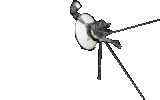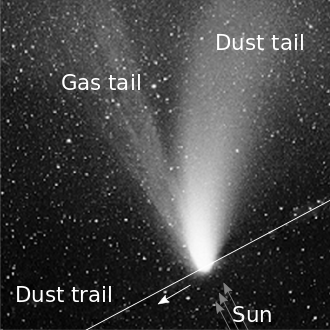
1.
Our Sun2.
Mercury Venus Our Moon Mars3.
Asteroid Belt4.
Jupiter Saturn Uranus Neptune5.
Pluto6.
Comets

A comet is an icy, small Solar System body that, when passing close to the Sun, warms and begins to release gases, a process called outgassing. This produces a visible atmosphere or coma, and sometimes also a tail.
Comet nuclei range from a few hundred meters to tens of kilometers across and are composed of loose collections of ice, dust, and small rocky particles. The coma may be up to 15 times Earth's diameter, while the tail may stretch one astronomical unit.
If sufficiently bright, a comet may be seen from Earth without the aid of a telescope. Comets have been observed and recorded since ancient times by many cultures.
Comets usually have highly eccentric elliptical orbits, and they have a wide range of orbital periods, ranging from several years to potentially several millions of years.
Comets are distinguished from asteroids by the presence of an extended, gravitationally unbound atmosphere surrounding their central nucleus. This atmosphere has parts termed the coma (the central part immediately surrounding the nucleus) and the tail (a typically linear section consisting of dust or gas blown out from the coma by the Sun's light pressure or solar wind.
The discovery of main-belt comets and active centaur minor planets has blurred the distinction between asteroids and comets.
As of July 2019 there are 6,619 known comets,a number that is steadily increasing as they are discovered. This represents only a tiny fraction of the total potential comet population, as the reservoir of comet-like bodies in the outer Solar System (in the Oort cloud) is estimated to be one trillion.
Reference: Wikipedia - Comet
A spacecraft mission
to explore our Solar System starts with its launch from earth using a rocket launcher. The spacecraft then uses its own engines to reach its objective and carry out its mission. Some missions have multiple objectives.
The duration of a mission varies, depending on the craft used and purpose of the mission.
The table below is an overview or all the successful spacecraft missions, to date, used to study Comets. It only includes spacecraft that left Earth orbit to perform their mission.
Point to ℹ for table information. (Table head remains visible while scrolling)
Select the Spacecraft name or Target for more information.
| Img | Spacecraft | Launcher | Country | Year | Target | Notes | |
| Launch | End | ||||||
| 1 | ICE | Delta-2914 | U.S. | 1978 | 2014 | 21P Giacobini-Zinner, 1P Halley |
ISEE-3 observed solar phenomena in conjunction with earth-orbiting ISEE-1 and ISEE-2. It was later renamed International Cometary Explorer (ICE) and directed to Comet Giacobini-Zinner where it passed through the plasma tail of comet within about 7,800 km of the nucleus in 1985. ICE flew through comet Halley's tail with a minimum distance to the nucleus of 28 million km. |
| 2 | Vega 1, Vega 2 |
Proton 8K82K | Russia | 1984 | 1987 | 1P Halley | Both had a landing probe and balloon to study the atmosphere and the surface of Venus. After releasing their landers both spacecraft were redirected by Venus' gravity to intercept and study Halley's Comet. |
| 3 | Sakigake | Mu-3S-II | Japan | 1985 | 1995 | 1P Halley | Japan's first interplanetary spacecraft, and the first deep space probe other than the U.S. and U.S.S.R. Observed space plasma and magnetic field in space. Used to improve the mission of the Suisei probe. Identical in construction and shape to Suisei, but carried a different payload. |
| 4 | Suisei | Mu-3S-II | Japan | 1985 | 1991 | 1P Halley | Took UV images of the hydrogen corona and measured solar wind parameters. Encountered Comet Halley at 151,000 km on sunward side during 1986, suffering only 2 dust impacts. Identical in construction and shape to Sakigake, but carried a different payload. |
| 5 | Giotto | Ariane 1 | Europe | 1985 | 1992 | 1P Halley, 26P Grigg-Skjellerup |
Flew by and studied Halley's Comet and was the first spacecraft to make close up observations of a comet. It approached the nucleus at a distance of 596 kilometers. Named after Renaissance painter Giotto di Bondone. Flew by the Comet Grigg-Skjellerup in 1992 at a distance of about 200 km. |
| 6 | Deep Space 1 | Delta II 7326 | U.S. | 1998 | 2001 | 9969 Braille, 19P Borrelly |
NASA technology demonstration spacecraft part of the New Millennium Program. Carried out a flyby of asteroid 9969 Braille and extended twice to include an encounter with comet 19P Borrelly. |
| 7 | Stardust | Delta II 7426-9 | U.S. | 1999 | 2011 | 5535 Annefrank, 81P Wild |
Flew by and studied the asteroid 5535 Annefrank en route to its primary mission to collect dust samples from the coma of comet 81P Wild (or Wild 2). |
| 8 | Deep Impact | Delta II 7925 | U.S. | 2005 | 2013 | 9P Tempel, 103P Hartley |
Studied the interior composition of comet 9P Tempel, by releasing an impactor which successfully collided with the comet's nucleus. This excavated debris from the interior of the nucleus, forming an impact crater. Flyby in 2010 of 103P/Hartley as part of the EPOXI mission. Was able to approach within 700 kilometers. |
| 9 | Rosetta | Ariane 5G, V-158 |
Europe | 2004 | 2016 | 2867 Šteins, 21 Lutetia, 67P Churyumov- Gerasimenko |
Part of ESA's Horizon 2000 programme. Flew past asteroids 2867 Šteins and 21 Lutetia. Rendezvoused with comet 67P Churyumov-Gerasimenko in 2014 and entered orbit. Rosetta's lander, Philae, landed on the comet's surface becoming the first spacecraft to land on a comet nucleus. |
| 10 | Tianwen-2 | Long March 3B | China | 2025 | 2035 | 469219 Kamoʻoalewa 311P PanSTARRS |
Sample return from asteroid 469219 Kamoʻoalewa in 2027, rendezvous with main-belt comet 311P PANSTARRS in 2035. |
This gallery contains images of spacecraft and their launch vehicles (rockets) used on the above missions. (Numbers relate to the table above)
Thumbnails: Click on a thumbnail image to enlarge it. | Enlarged image: Click on right side of image for next image or on left side for previous image. Click outside image to close.